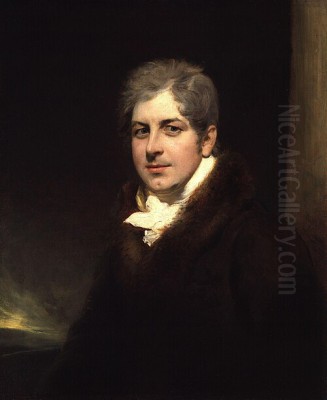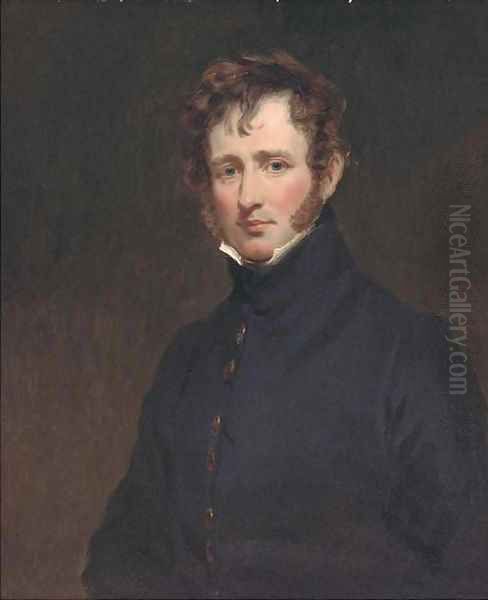
George Henry Harlow stands as a fascinating, albeit tragically brief, figure in the landscape of British art during the Regency period. Born in London on June 10, 1787, and dying there prematurely on February 4, 1819, his career spanned little more than a decade. Yet, in that short time, he established himself as a notable painter, particularly celebrated for his vibrant portraits of theatrical personalities and his ambitious, though less consistently successful, historical compositions. Working in the shadow of the dominant portraitist Sir Thomas Lawrence, Harlow developed a style that, while indebted to his mentor, possessed its own distinct energy and flair.
Early Life and Artistic Awakening
George Henry Harlow was born in St James's Street, London. His father, an English merchant who had spent considerable time in China and the East Indies, died some five months before George's birth, leaving his widow with a young family. From an early age, Harlow displayed a clear inclination towards art. His formal education began at Dr. Barrow's classical school in Soho Square, followed by a period at Mr. Roy's school in Burlington Street. He also spent a short, apparently undistinguished, time at Westminster School.
Recognizing her son's artistic passion over academic pursuits, Harlow's mother facilitated his entry into the world of art. His first mentor was the Flemish landscape painter Hendrik Frans de Cort. However, landscape painting did not hold Harlow's interest for long. His true calling lay in capturing the human form and character, leading him to seek instruction more suited to figure painting and portraiture.
Training and the Influence of Lawrence
Harlow's next step was to become a pupil of Samuel Drummond, ARA, a painter known for both portraits and historical subjects. Harlow applied himself diligently under Drummond for about a year, making rapid progress. However, contemporary accounts suggest Harlow's burgeoning talent was matched by a growing sense of self-importance, leading to friction with his teacher. This pattern of confidence, sometimes perceived as arrogance, would recur throughout his short life.

The most significant relationship in Harlow's artistic development was with Sir Thomas Lawrence, the pre-eminent portrait painter of the age. Introduced to Lawrence's studio around 1803, possibly through the influence of the Duchess of Devonshire, Georgiana Cavendish, Harlow was not a formal apprentice in the traditional sense. Lawrence, known for his charm but perhaps less for systematic teaching, allowed Harlow access to his studio and employed him, reportedly for about eighteen months, to prepare canvases and paint drapery and subordinate parts of portraits.
Harlow absorbed Lawrence's style with remarkable speed and facility. He learned to emulate the older master's fluid brushwork, elegant compositions, and flattering depictions. An anecdote often recounted involves a portrait of Mrs. Angerstein; Harlow worked on the drapery and background, and upon its completion, allegedly claimed a significant share in its success, much to Lawrence's displeasure. This incident, whether entirely accurate or embellished over time, highlights both Harlow's skill and his sometimes-difficult personality, leading to a cooling of relations with Lawrence. Despite this, Lawrence's influence remained palpable throughout Harlow's career.
Developing an Independent Path
Although deeply influenced by Lawrence, Harlow sought to establish his own artistic identity. He began exhibiting at the Royal Academy in 1804, initially showing a portrait of his mother. He continued to exhibit regularly, primarily portraits but also occasional subject pictures. His talent was undeniable, marked by strong draughtsmanship and a vibrant sense of colour, sometimes richer and bolder than Lawrence's more refined palette.
Harlow possessed a precocious talent and a confidence that could be interpreted as vanity. He was known for his good looks and fashionable dress, cutting a figure in London society. This self-assurance, however, sometimes hindered his professional relationships. He reportedly criticized the Royal Academy's teaching methods and held strong opinions about art, which did not always endear him to the establishment figures. The influential history painter Henry Fuseli is said to have remarked that Harlow was the "most promising of all [the young painters] but intractable," suggesting both immense potential and a difficult temperament.
Despite these challenges, Harlow quickly built a successful practice. He attracted numerous commissions, particularly from the burgeoning middle class and, most notably, from the world of theatre. His ability to capture a likeness, combined with a certain dramatic flair, made him a popular choice for those seeking a portrait that was both accurate and engaging.
Portraits of the Stage: The Kemble Family
Harlow's most enduring fame rests on his portraits of theatrical figures. The London stage was a vibrant centre of cultural life during the Regency, and actors and actresses enjoyed a level of celebrity akin to modern stars. Harlow became particularly associated with the Kemble family, the dominant theatrical dynasty of the era.
His most famous work is the large group portrait known variously as The Trial of Queen Katherine, The Court for the Trial of Queen Katharine, or simply The Kemble Family (completed around 1817). This ambitious painting depicts the trial scene from Shakespeare's Henry VIII, featuring portraits of several members of the Kemble family in character. John Philip Kemble appears as Cardinal Wolsey, his sister, the legendary Sarah Siddons, as Queen Katherine, Charles Kemble (their younger brother) as Thomas Cromwell, Stephen Kemble as Henry VIII, and others associated with the production.
The painting was a bold undertaking, combining portraiture with the complexity of a historical composition. It aimed to capture not just the likenesses of the famous actors but also the drama and pageantry of the scene. While some critics found fault with its composition or historical accuracy, the work was immensely popular with the public and cemented Harlow's reputation as the pre-eminent painter of the stage. It showcased his skill in capturing individual likenesses within a complex narrative setting, a challenge few portraitists attempted on such a scale. He also painted individual portraits of stars like the singer Kitty Stephens, further solidifying his connection to the theatrical world. His work in this area can be seen as continuing a tradition of theatrical portraiture established by earlier artists like Johan Zoffany and Samuel De Wilde, but with the added gloss and scale characteristic of the Regency.
Ambitions in History Painting
Like many ambitious artists of his time, Harlow aspired to success in history painting, considered the highest genre of art according to academic principles established by figures like Sir Joshua Reynolds. While portraiture provided his main income and fame, Harlow periodically produced historical and subject pictures, often exhibited at the Royal Academy or the British Institution.
One notable example is The Presentation of the Cardinal's Hat to Wolsey in Westminster Abbey (or similar titles). This work, like the Kemble group portrait, focused on a historical subject featuring Cardinal Wolsey, indicating Harlow's interest in dramatic moments from British history. He also painted subjects like Hubert and Prince Arthur from Shakespeare's King John.
However, Harlow's history paintings generally received less acclaim than his portraits. While often demonstrating technical skill and dramatic composition, they perhaps lacked the depth or originality required to make a major impact in a field dominated by established figures like Benjamin West, the President of the Royal Academy for many years. Harlow's true strength lay in capturing the living presence and personality of his sitters, a skill more suited to portraiture than the grand narratives of history painting.
The Italian Journey
In 1818, seeking further artistic development and recognition, Harlow embarked on a journey to Italy. He travelled with introductions to prominent figures, including the renowned neoclassical sculptor Antonio Canova. In Rome, Harlow dedicated himself to studying the Old Masters. His most significant undertaking was creating a full-size copy of Raphael's final masterpiece, the Transfiguration, located in the Vatican.
This was a monumental task, requiring immense dedication and skill. Harlow worked diligently, and his copy was widely admired for its accuracy and technical brilliance. Canova, a leading figure in the Roman art world, was particularly impressed, reportedly praising Harlow's talent extravagantly and comparing him favorably to artists like Anthony van Dyck. This high praise from such an esteemed source significantly boosted Harlow's reputation.
While in Rome, Harlow was elected a member of the prestigious Accademia di San Luca on the recommendation of Canova, an honour rarely bestowed on foreign artists so quickly. He also painted portraits of Canova and Pope Pius VII. His time in Italy was a period of intense activity and recognition, marking a high point in his career. He mingled with other British artists and patrons on the Grand Tour, absorbing the artistic atmosphere of the Eternal City.
Return, Triumph, and Untimely Death
Harlow returned to London in January 1819, his reputation enhanced by his Italian successes. His copy of the Transfiguration was exhibited to great acclaim, first in his studio and then at the Royal Academy. Commissions for portraits flowed in, and it seemed he was poised for even greater achievements, potentially challenging Lawrence's dominance in the long term.
Tragically, this promise remained unfulfilled. Shortly after his return, Harlow contracted a severe throat infection – described variously in contemporary accounts, possibly a complication of mumps or, more likely, diphtheria ("cynanche tonsillaris"). Despite medical attention, his condition worsened rapidly. George Henry Harlow died on February 4, 1819, at the age of just 31. His death shocked the London art world, cutting short a career filled with talent and potential. He was buried under the altar of St James's Church, Piccadilly.
Artistic Style and Technique
Harlow's style is best understood as a dynamic offshoot of the prevailing Regency portrait aesthetic, largely defined by Sir Thomas Lawrence. He adopted Lawrence's fluid brushwork, emphasis on elegance, and ability to flatter his sitters. However, Harlow's work often possesses a bolder energy, stronger colour contrasts, and perhaps a more direct, less idealized approach to character, particularly in his male portraits.
His draughtsmanship was generally strong, providing a solid foundation for his painterly technique. He excelled at rendering textures, particularly rich fabrics like silks and velvets, which added to the visual appeal of his portraits. While capable of capturing delicate female beauty, as seen in portraits like that of Kitty Stephens, he often brought a particular vigour to his depictions of men, including fellow artists like James Northcote and Henry Fuseli.
Compared to other contemporary portraitists like John Hoppner, Sir William Beechey, or Sir Martin Archer Shee (who would eventually succeed Lawrence as President of the Royal Academy), Harlow's work often appears more vibrant and modern, closer in spirit to Lawrence's dynamism. While perhaps lacking the psychological depth of a predecessor like Reynolds or the poetic sensibility of Thomas Gainsborough, or the rugged strength of the Scottish master Sir Henry Raeburn, Harlow's portraits effectively captured the spirit of his age – confident, theatrical, and stylish.
Legacy and Reputation
George Henry Harlow's legacy is that of a brilliant talent extinguished far too soon. In just over a decade of professional activity, he produced a significant body of work, primarily portraits, that captured the likenesses of many key figures of the Regency era, especially those connected with the theatre. His group portrait of the Kemble family remains an iconic image of the British stage.
He occupies a distinct place in British art history, overshadowed by his mentor Lawrence but recognized for his own considerable skills and distinct artistic personality. Had he lived longer, he might well have developed into a major force, potentially offering a stylistic alternative or challenge to Lawrence's pervasive influence. His early death left a void and prompted speculation about what might have been.
His works are held in major collections, including the National Portrait Gallery in London, the Tate Britain, the Garrick Club (which holds significant theatrical portraits), and various regional museums. While not an innovator on the scale of J.M.W. Turner or John Constable, who were revolutionizing landscape painting during the same period, Harlow was a highly accomplished portraitist whose work provides a vivid window into the society and culture of Regency Britain. He remains remembered as a painter of great promise, whose vibrant depictions, especially of the theatrical world, continue to engage viewers today.